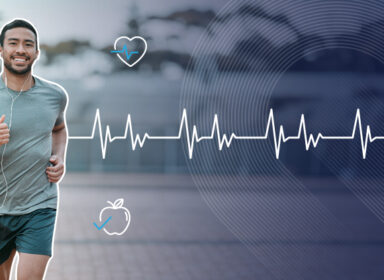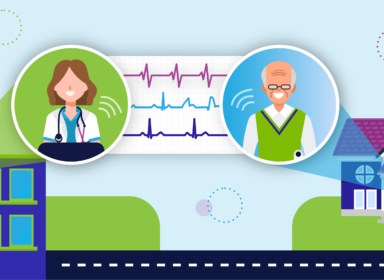In the past several years, the rise of technology in medicine has caused a shift towards practice that prioritizes convenience and immediacy. The results of this shift can be seen everywhere, from the rise of telehealth to the increase of remote monitoring devices used to manage a wide range of medical issues in a way that grants more freedom to patients.
But it isn’t just patients who benefit from the rise in virtual care—80% of providers feel that virtual care improves their ability to care for patients. With this in mind, it’s no surprise that flexible, wearable devices are gaining interest and increasing in utilization. These non-invasive, comfortable-to-wear patches and sensor can support continuous or contiguous observation, so they are useful in scenarios that require more patient oversight.
One example that holds outsized potential to positively impact the convenience and quality of care is the ECG patch. A large portion of the US population has cardiac-related conditions—1 in 2 adults has hypertension, and 6.1 million have atrial fibrillation. When we look at these numbers, it’s no surprise that the ECG patch has emerged as a useful and widely leveraged tool in modern cardiac care.
But what exactly is an ECG patch, and how does it work? This blog post will detail what an ECG patch is, what it isn’t, and its key benefits.
What an ECG Patch Is
An ECG patch, or electrocardiogram patch, is a medical device that monitors a person’s heart activity continuously and remotely over an extended period. ECG patches are typically small, lightweight, and adhesive, making them comfortable for patients to wear for extended periods, ranging from a few days to a few weeks. There are many relevant use cases for this remote monitoring device, including diagnosis and management of arrhythmias, assessment of heart function post-surgery, and surveillance of patients at risk of cardiac events, among others.
The ECG patch is more than a step change in monitoring that is better suited for a virtual care reality. Its use can deliver significant and sweeping benefits for patients and providers alike. Let’s look at a few of the ECG patch’s benefits and explore some of the potential drawbacks to this useful tool.
The ECG Patch’s Benefits
The patch has many benefits, including convenience for patients, continuous monitoring for providers, and the ability to transmit reliable data quickly and efficiently. Here we will explore the top three contenders for the greatest benefit provided:
Benefit 1: Convenience
Ease of use is a key benefit of an ECG patch. Patients can wear patches discreetly under their clothing and go about their daily activities without interruption, making the devices more convenient than traditional monitors. This is because they are non-invasive and don’t require electrodes or wires inserted into the body, which also makes them more comfortable for patients. This convenience helps encourage patient adherence.
ECG patches also allow healthcare providers to remotely access and review a patient’s data only when paired with either a secondary access relay or an onboard SIM capability, which reduces the need for inconvenient in-person visits and allows for more efficient use of healthcare resources. It also facilitates monitoring patients in remote or underserved areas where access to in-person services may be scarce or difficult to access. In addition to promoting more patient freedom and convenience, the Wi-Fi capabilities of ECG patches provide enhanced connectivity.
When it comes to patient well-being, one of the primary benefits of cellular connectivity is the ability to detect and respond to cardiac events as they occur. Wireless connectivity enables remote monitoring by healthcare providers, allowing immediate intervention if critical cardiac events are detected. When paired with near real-time data transmission and continuous monitoring, this supports physicians having a once unheard-of level of continuity.
Problem solved: Patient adherence.
Benefit 2: Continuity
As mentioned above, when wireless connectivity facilitates near real-time data transmission, which minimizes the risk of data loss, as ECG data is sent directly to a secure server or healthcare provider’s system, ensuring that it is reliably stored and can be reviewed and analyzed at any time. This supports continuous monitoring rather than the typical contiguous monitoring, yet today most patches do not communicate. They must be worn for the prescribed amount of time and mailed back to the processing center for data analysis—negatively impacting a provider’s ability to detect patterns as they are occurring or other important factors for diagnosis.
Continuous monitoring through remote connectivity allows providers to keep a close watch on patients’ heart activity, even when they are at home or elsewhere—which is particularly useful for managing post-op patients or those with chronic conditions. This is because continuous monitoring provides a more comprehensive and constant view of a patient’s heart activity over an extended period. This can help healthcare providers correlate patient symptoms with their ECG data and allows for more accurate diagnoses and treatment plans, especially for conditions with variable symptoms requiring a fuller picture of patient data.
Problem solved: Data gaps and drops.
Benefit 3: Clinical Flexibility
Connected and communicating ECG patches can provide the clinician direct access to important cardiac data rather than through an intermediary or by episodic transmission. By providing clinicians with immediate access to near real-time ECG data, ECG patches address the historical challenge of ensuring timely interventions. Clinicians can quickly identify cardiac events or abnormalities and intervene promptly, reducing the risk of complications.
This equips providers with clinical flexibility and optimizes the timely detection of cardiac events, which can be crucial in cases of arrhythmias, heart attacks, or other cardiac emergencies. This early detection can prevent complications such as stroke, and immediate medical attention truly make a significant difference in a patient’s outcome where their life is on the life.
Problem solved: Intervention timeliness.
ECG Patch Drawbacks
Very few medical devices come without any drawbacks. While ECG patches are revolutionary, they do have a few potential issues, including:
Drawback 1: Poor Battery Life and Data Interruptions
The battery life of ECG patches can be limited and, in some cases, battery replacement or recharging may interrupt monitoring. The interruption of data can cause vital information loss and prevent providers from identifying important patterns or recognizing less frequent symptoms, which in turn can delay early intervention.
This can also limit freedom for patients by restricting the length of time they can go between recharging. The larger implication here is the impact that battery life may have on patient adherence, as patients are less likely to continue using a device that is inconvenient to their daily lives. When identifying an ECG patch, providers should prioritize long-lasting battery life and internal storage so no data is lost due to interruptions in device communications.
Drawback 2: Coverage Limitations
Another obstacle to the adoption of ECG patches is that there may be limitations across specific cellular connection types. While ECG patches rely on wireless connectivity to power their remote monitoring capabilities, the nature of the device’s connectivity can vary based on its manufacturer, model, and purpose. Some ECG patches might use Wi-Fi, while others may utilize Bluetooth to cellular networks (3G, 4G, or 5G), or proprietary wireless protocols.
When it comes to Wi-Fi specifically, the connection relies on the availability of Wi-Fi networks. ECG patches may struggle to maintain a consistent connection in areas with poor or no Wi-Fi coverage, such as remote or rural locations, or in certain healthcare facilities with limited network infrastructure. Patients may not be willing to structure their daily lives around Wi-Fi availability, which can result in data loss or worse, non-adherence.
In addition, relying solely on Wi-Fi leaves the device open to interference from other Wi-Fi devices or electronic equipment. This interference can lead to data packet loss or errors in the ECG recordings. It is critical that providers select devices with multicarrier compatibility and reliable data transmission.
Drawback 3: Data Overload
While data loss is a concern when it comes to coverage limitations, an uninterrupted system presents the opposite challenge. Continuous monitoring can generate a significant amount of data, which may require substantial time and effort to review and analyze.
This has the potential to lead to information overload for providers. The constant influx of high-volume data can also slow prognosis or delay life-saving interventions due to review cycles, even if this data is more accurate and comprehensive. AI-enabled solutions, however, can sift through significant amounts of data rapidly to surface meaningful insights and present them to cardiologists for data-driven decision-making.
Drawback 4: Few Sensor Variations
Many ECG patches on the market only have one lead (sensor). While adequate for lower acuity patients, more intensive cardiac monitoring requires more leads in order to paint a clearer picture of the patient’s heart activity.
The ideal device has will provide a variety of untethered lead sets. For example, a comprehensive remote monitoring solution may provide a single lead ECT patch, a 3-lead sensor that provides 6-lead ECG data, or a 4-lead sensor that provides 7-lead ECG data.
The Future of the ECG Patch Looks Bright
InfoBionic believes in the benefits ECG patches provide—but we aren’t blind to the ways in which many of the industry’s current models fall short. That’s why we take the challenges ‘heart-on’ with our approach to virtual telemetry. Our solution builds upon the convenience, continuity, and clarity afforded to patients and providers while effectively addressing drawbacks like battery life, coverage, data overload, and configurability.
Through our commitment to quality and innovation, we continue to find new ways to extend battery life, bridge gaps between communication and provide discreet untethered sensors for the ultimate quality in ECG signal and patient convenience. Our wireless sensors provide the ultimate quality, securely transmitting high-fidelity cardiac arrhythmia detection data to clinicians in near real-time. And our plan for flexible lead configurations will be designed to support a complete range of data acuity—from more advanced cardiac use cases to on-the-go monitoring. Finally, to combat the strain of truly continuous data, we utilize AI-assisted automation in a way that reduces clinical burden and accelerates clinical workflows.
Reach out today to learn how the MoMe® ARC can help you step into the future of remote cardiac monitoring.


